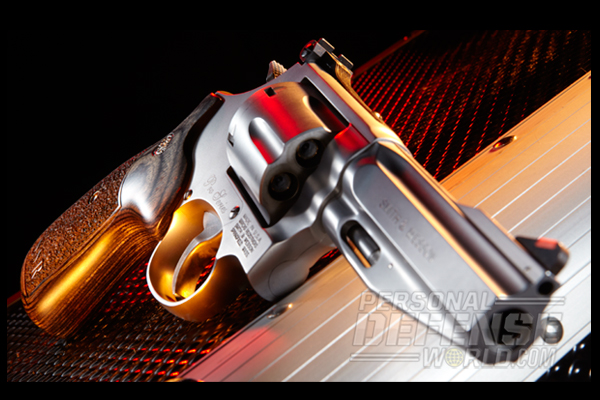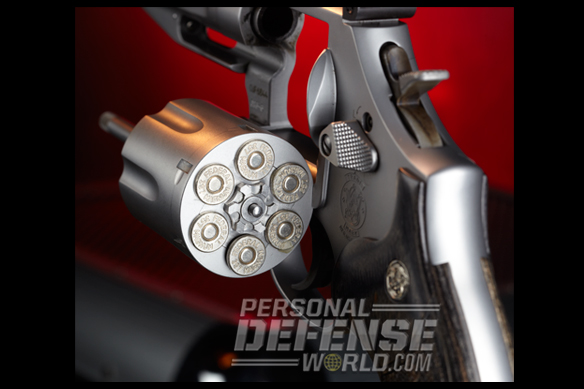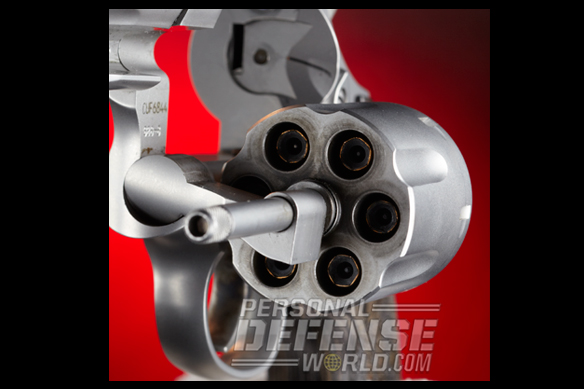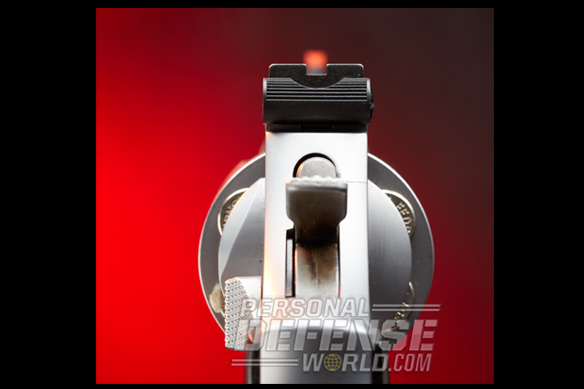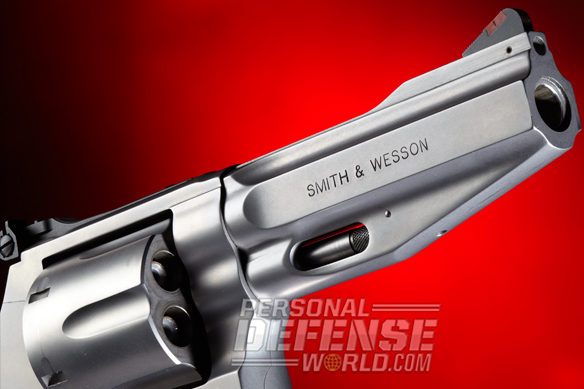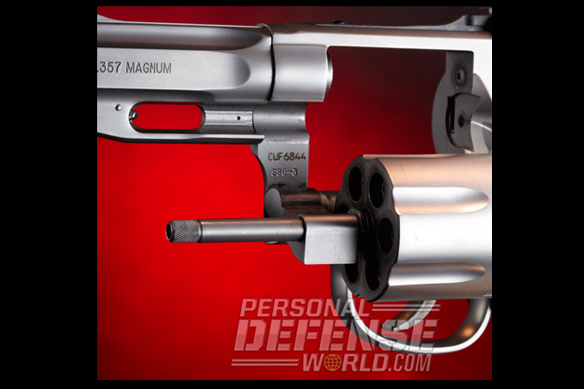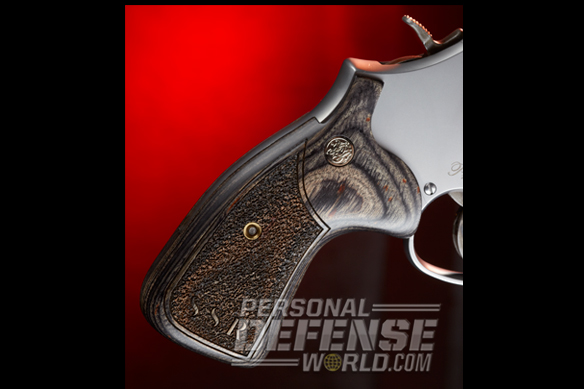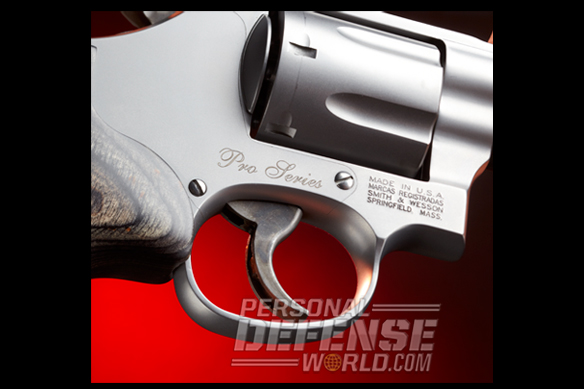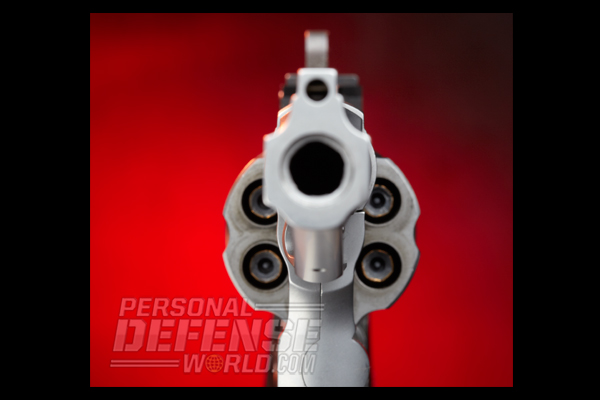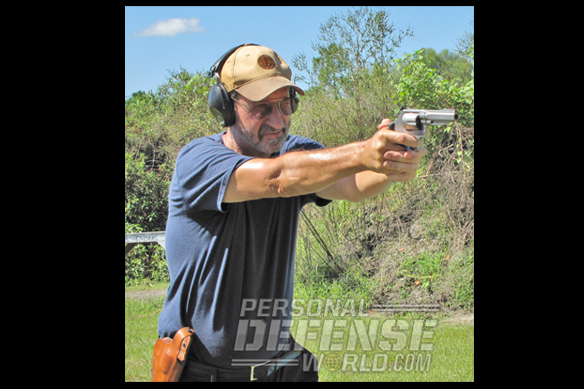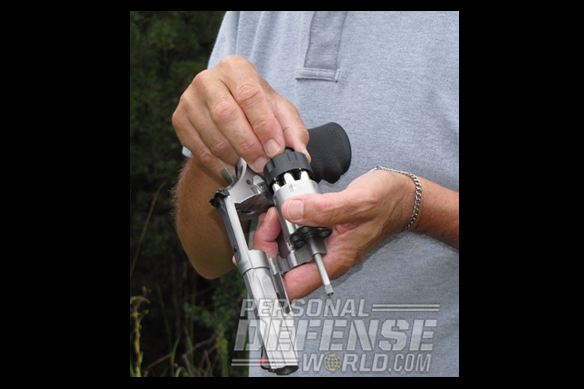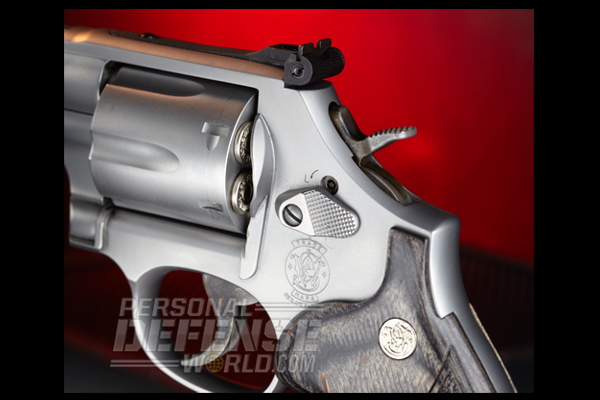Service revolvers were invented 177 years ago, but for many shooters they are still viable choices for self-defense. The secret to the wheelgun’s longevity lies in its ease of use and in the fact that manufacturers are continually updating it. Smith & Wesson is well known for producing state-of-the-art revolvers, and one of the latest from S&W is the M686 Pro Series .357 Magnum Stock Service Revolver (SSR). The SSR is more than just another update. It sets a new standard for service revolvers. Pro Series guns blend high-tech production line manufacturing with custom features that were only available previously through the S&W Performance Center. Even though the SSR is made on the regular production line, it has chamfered charge holes, a custom 4-inch barrel with a recessed precision crown, a bossed mainspring and an ergonomic wood grip that is designed to give a high hand hold for better recoil control. All of this comes at a cost of only $160 more than the standard 4-inch, six-shot M686. That’s the average cost of about 150 rounds of premium jacketed hollow-point (JHP) ammunition.
“The custom features of the SSR provide advanced handling qualities that maximize the ‘Jack of All Trades’ nature of revolvers.”
Advertisement — Continue Reading Below
“The custom features of the SSR provide advanced handling qualities that maximize the ‘Jack of All Trades’ nature of revolvers.”
Advertisement — Continue Reading Below
GUN DETAILS:
When the SSR arrived at the Florida Gun Exchange, everyone who looked at it and picked it up was impressed by its good looks. The custom 4-inch barrel is a real eye-catcher, and so are the wood grips. They also liked the gun’s grip-heavy balance. This makes the SSR quick to bring on target when drawn from a holster, and it also makes it swing with little effort. A smooth, effortless swing is important when engaging multiple targets. There were no obvious defects in workmanship on the exterior of the SSR, so I took it home and gave it a detailed bench examination. A close examination for tool marks and conformity indicated that all surfaces were thoroughly finished, markings were crisp and evenly impressed, and there were no uneven lines or sharp edges. Chambers were evenly chamfered, the bolt notches were square, and facets on the extractor were properly conformed and clean edged. In addition, the alignment of the cylinder crane was straight, with no gap between the crane and frame, and the bore was bright with clean-cut rifling.
The cylinder/barrel gap measured 0.006-inches on all chambers. Given the gun’s good fit and finish, it was no surprise that it functioned well. Timing was dead-on, and the bolt locked on all chambers well before the hammer was at full-cock. The double-action (DA) and single-action (SA) trigger pulls were very smooth. There was no increase in effort (i.e., stacking) as the trigger was pulled to the rear. The DA trigger pull was consistently 10 pounds to 10.5 pounds, and SA pull was 3.5 pounds to 4 pounds. The sear broke cleanly with about 0.125 inches of overtravel. The action was very good for a stock revolver, and at least some of this fine performance can be attributed to the use of a bossed mainspring. The SSR came with an extra set of Hogue black rubber Monogrips, which were installed during the bench examination. The wood grips were nicely made, but too small for my extra-large hands. Therefore, all shooting was done with the Hogue grips.
Advertisement — Continue Reading Below
RANGE TIME:
The SSR was fired for accuracy and velocity at the Volusia County Gun & Hunt Club. Tactical drills were run at the Volusia Club, and the SSR was also used to fire the Army L Course at the Flagler Gun & Archery Club during a weekly “bullseye” match. Accuracy and velocity tests were conducted with five loads that were graciously provided by their manufacturers. These included Black Hills’ .38 Special 148-grain wadcutter (WC), HPR’s .38 Special 158-grain XTP HP, Winchester’s 125-grain PDX1 .357 Magnum, Remington’s 125-grain .357 Magnum SJHP and CorBon’s 140-grain .357 Magnum JHP. Accuracy tests were performed at 25 yards. An MTM front sight rifle rest was used to support the gun, and a Leupold Kenai spotting scope was used to check groups. Averages for three 5-shot groups ranged from 2.4 inches with the Black Hills .38 Special 148-grain wadcut ters to 4.07 inches with Winchester’s 125-grain PDX1 .357 Magnum load. The best single group, fired with the Black Hills wadcutters, measured 1.64 inches. The 125-grain magnum loads printed about 1.5 inches lower than the CorBon 140-grain magnum load, and about 2.5 inches lower than the 148-grain and 158-grain .38 Special loads. Since the 140-grain loads were dead-on, I chose not to change the sights. The sights needed no adjustment prior to testing. The SSR printed dead-on from the factory.
Velocity tests were conducted using a Pact 1XP chronograph. Five shots of each load were measured at a distance of 15 inches from the muzzle. The fastest load was Remington’s 125-grain .357 Magnum SJHP; it averaged 1,472 feet per second (fps). The latest version of Sierra’s Infinity Ballistic software indicates that this velocity generates 601 foot-pounds of muzzle energy. The Remington 125-grain SJHP magnum load isn’t new, and it’s not bonded, but it’s been a very consistent performer over the past 30 years. The slowest load was Black Hills’ 148-grain wadcutter target load. All of the other loads produced velocities that were close to factory ballistics.
Advertisement — Continue Reading Below
The Army L bullseye match was fired with Winchester’s 125-grain PDX1 Magnums. Tactical drills were fired with Remington’s .38 Special 130-grain FMJ load and the CorBon and Remington .357 Magnum loads. There were no misfires or mechanical problems during the drills or any other live fire tests. The SSR easily digested every load it was fed. During the bullseye match, I shot the SSR one-handed for the 25-yard slow fire, and two-handed for the 25-yard timed fire and 15-yard rapid-fire stages. Slow fire was shot in the SA mode, and the other two stages were fired DA. All shots were on target during each stage, and the best score was a 93-5X during the 15-yard, rapid-fire stage. The SSR’s 38-ounce weight handled recoil very well, and the Hogue grips provided for a very solid purchase on the gun. Two tactical drills were conducted. I did both wearing a Blackhawk thumb-break holster that I had converted from a 6-inch closed bottom holster to a 4-inch one with an open bottom. The first drill involved moving laterally off the X while drawing and then firing double or triple taps at two simulated assailants at 7 yards. One target presented body shots and the other headshots. The SSR’s slightly grip-heavy balance made for fast presentations and helped it point very well.
The second drill involved a simulated house clearing. The shooter opened a door into a hallway that had two simulated assailants standing behind a barrel. One assailant partially covered the other. The more exposed target offered upper body and headshots, while the second had only the head and gun arm/hand visible. Each target was double tapped from the cover of the doorway. I then moved quickly down the hall and engaged a third simulated assailant who was standing 15 yards past the end of the hallway, in an open area. The third target was double tapped. I then performed an emergency reload from cover, reacquired the target and shot twice again. The SSR’s tactical performance was excellent. All shots during both drills landed in vital areas. There was no decrease in tactical accuracy when magnum loads were used. In addition, the chamfered charge holes made reloads with the Safariland speedloader fast and easy. Combine this performance with the results of the accuracy and velocity tests, and it’s clear that the SSR is a well-rounded and very practical revolver.
Advertisement — Continue Reading Below
FINAL THOUGHTS:
The SSR clearly proves that rumors of the service revolver’s demise are indeed premature. Revolvers may not have the firepower of semi-autos, but they can still deliver telling blows, especially when loaded with magnum ammunition. Combine this with the revolver’s ease of use and ability to be loaded with light or heavy loads, and you have a handgun that can be shot by individuals of different skill levels, and used for everything from target shooting to personal defense and hunting. The custom features of the SSR provide advanced handling qualities that maximize the “Jack of All Trades” nature of revolvers, making this new gun from Smith & Wesson a very good choice for many of today’s shooters.
For more information on the Smith & Wesson M686 SSR .357 Magnum, visit smith-wesson.com or call 800-331-0852.
